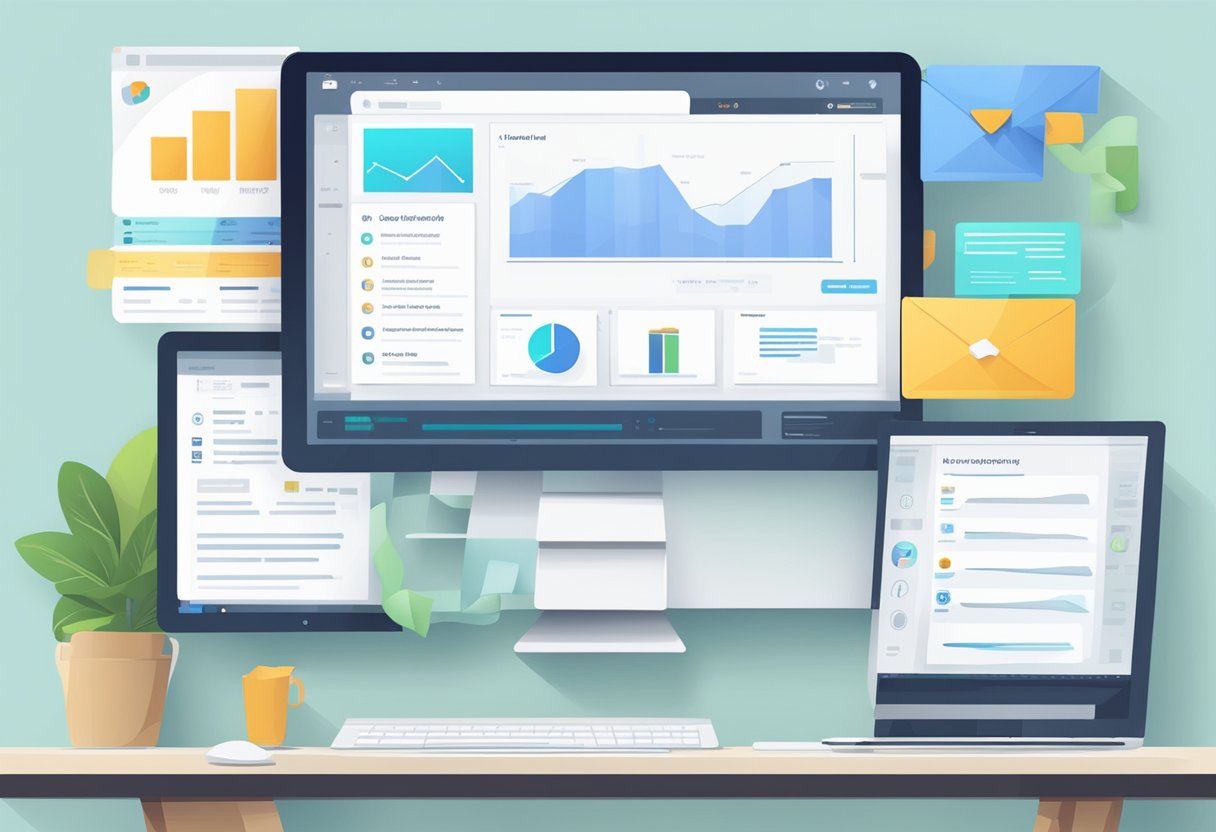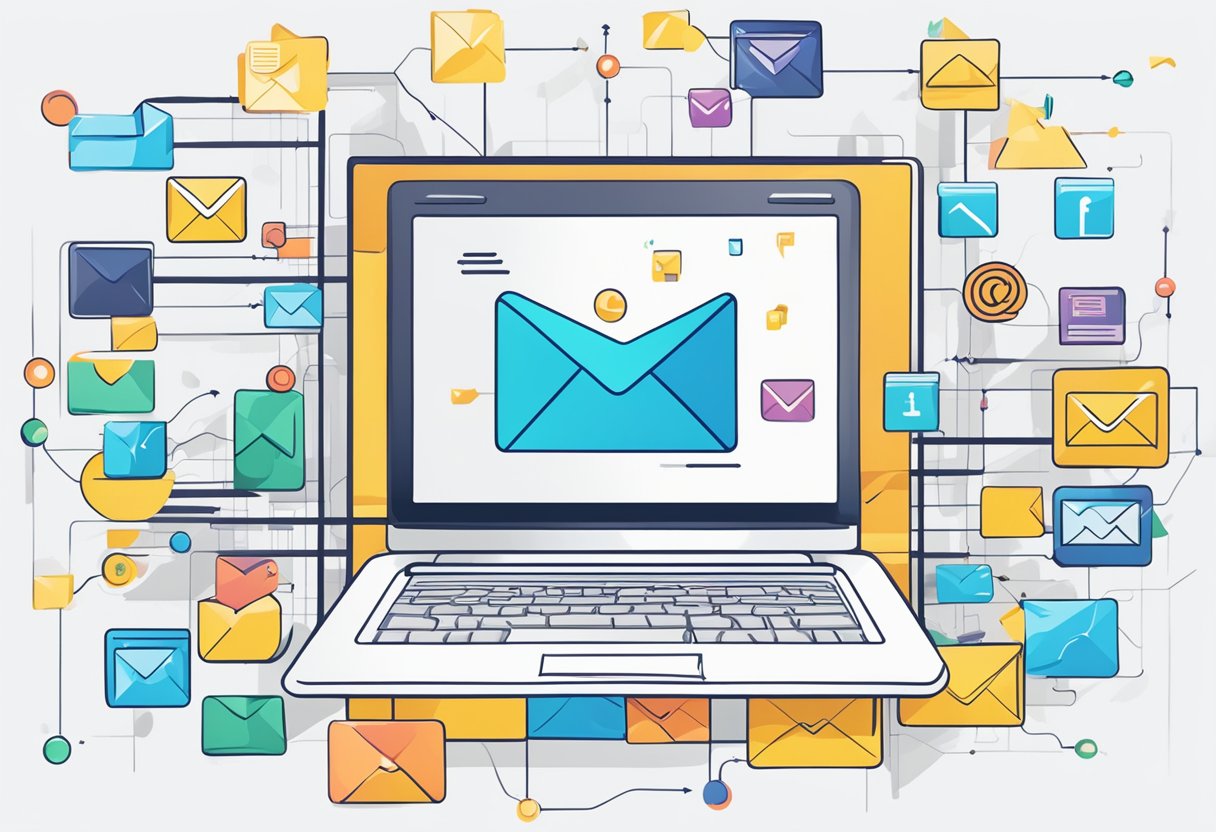Best Email Marketing Software: Top Solutions for Effective Campaigns
Email marketing remains a powerful tool for businesses to connect with their audience. Choosing the best email marketing software can enhance engagement, streamline processes, and boost conversion rates. With numerous platforms available, finding the right one can be overwhelming. This guide aims to simplify that choice, showcasing the top email marketing software to meet diverse business needs.

Effective email marketing software equips businesses with essential features such as automation, analytics, and audience segmentation. These tools enable marketers to design engaging emails, optimize workflows, and track performance metrics. By understanding these functions, businesses can leverage their email campaigns to achieve greater success.
As this article progresses, readers will explore various software options and what makes them standout. From pricing to features, this resource will assist anyone in making an informed decision that aligns with their marketing goals.
Key Takeaways
- The right email marketing software enhances user engagement and conversion rates.
- Key features include automation, analytics, and audience segmentation.
- This guide offers insights into the best tools available for effective email marketing.
Understanding Email Marketing
Email marketing is a powerful tool that helps businesses connect with their audience. It focuses on creating effective email campaigns that can engage customers while boosting sales and brand loyalty. Personalization plays a crucial role in making these campaigns successful.
Essence of Email Campaigns
Email campaigns are strategic messages sent to a list of subscribers. They can serve many purposes, such as promoting products, sharing updates, or providing valuable content. Each campaign should have clear goals, whether to drive traffic to a website or increase customer engagement.
Key components of an effective email campaign include:
- Target Audience: Identifying the right audience helps tailor the message.
- Compelling Subject Lines: These capture attention and encourage opens.
- Clear Calls to Action (CTAs): CTAs guide readers on what to do next.
Using a reliable email marketing platform can streamline campaign creation. Features like automation and analytics allow businesses to track performance and adjust strategies as needed.
Significance of Personalization
Personalization in email marketing refers to tailoring content to meet the specific needs and preferences of individual subscribers. This can include using a subscriber’s name or recommending products based on previous purchases.
Benefits of personalization include:
- Higher Open Rates: Personalized emails often attract more attention.
- Increased Click-Through Rates (CTR): Relevant content encourages engagement.
- Stronger Customer Relationships: Personalization fosters a connection between the brand and the subscriber.
An effective email marketing strategy should prioritize personalization at every stage. Leveraging data analytics can help businesses understand their audience better, leading to more effective email campaigns.
Choosing the Right Email Marketing Software
Selecting the right email marketing software involves understanding specific tools, features, and pricing plans available. A careful evaluation will help in making an informed decision that best meets marketing needs.
Evaluating Email Marketing Tools
When evaluating email marketing tools, potential users should consider ease of use, integration capabilities, and customization options. Tools like Mailchimp and HubSpot are user-friendly and offer robust features that cater to various business needs.
It’s essential to look for software that integrates smoothly with existing systems such as e-commerce platforms and Customer Relationship Management (CRM) tools. Additionally, customization options allow users to create personalized campaigns that resonate with their audience.
A trial period or free plan can provide valuable hands-on experience before making a commitment.
Critical Features of Marketing Software
Key features of email marketing software include automation, analytics, and A/B testing. Automation tools save time by scheduling emails and sending personalized messages based on user behavior.
Analytics help users track open rates, click rates, and subscriber behavior, providing insights that drive improvements. A/B testing enables marketers to test different email versions to determine which ones perform better.
Other essential features to consider are templates, list segmentation, and responsive design to ensure emails look good on all devices.
Comparing Free Plans and Pricing Structures
Free plans often serve as a great starting point for small businesses or those exploring email marketing. Many platforms, like MailerLite and Brevo, offer limited features at no cost, which can be sufficient for startups.
When comparing pricing structures, look for plans that grow with the business. Some platforms charge based on the number of subscribers, while others offer tiered pricing based on feature access.
Understanding the total cost of ownership, including possible add-ons or costs for exceeding limits, is crucial for budgeting. Choosing the right pricing plan can impact the effectiveness and reach of email marketing strategies.
Designing Engaging Emails
Creating engaging emails is essential for effective email marketing. Two key components that help achieve this are using email templates and employing drag-and-drop editors. These tools simplify the design process, making it accessible for anyone.
Using Email Templates Effectively
Email templates are pre-designed layouts that save time and enhance email consistency. They offer structured designs, which help in organizing content like headings, images, and calls to action.
Benefits of Using Templates:
- Consistency: Templates ensure uniform branding across all emails.
- Saves Time: Ready-made designs allow quicker deployment.
- Mobile Responsiveness: Many templates are optimized for mobile viewing, which is crucial as many users check emails on phones.
When selecting templates, focus on those that align with the campaign’s goals. Clear, attractive layouts encourage greater reader engagement.
Elevating Design with Drag-and-Drop Editors
Drag-and-drop editors enable users to customize email designs easily. These tools allow users to place elements like images, text boxes, and buttons wherever they want.
Key Features of Drag-and-Drop Editors:
- User-Friendly: They require no coding skills, making design accessible to everyone.
- Creative Freedom: Users can experiment freely with layouts and styles.
- Interactive Elements: Many editors include options for GIFs, videos, and clickable links, enhancing user engagement.
By utilizing drag-and-drop editors, marketers can create visually appealing emails that resonate with recipients. This flexibility can lead to higher open and click-through rates.
Segmentation and Target Audience
Segmentation is essential in email marketing. By understanding the target audience, marketers can create tailored messages that resonate with different groups. This approach increases engagement and conversion rates.
Importance of Segmentation
Segmentation helps marketers divide their audience into smaller groups based on specific characteristics. These can include demographics, interests, purchase history, and behavior patterns.
Benefits of Segmentation:
- Personalization: Tailored content increases relevance and value to recipients.
- Improved Engagement: Segmented emails see higher open and click-through rates.
- Increased Revenue: Targeted campaigns often lead to more sales.
Segmentation allows businesses to send the right message at the right time, enhancing customer relationships. It also helps identify trends and preferences within different segments, making marketing strategies more effective.
Building and Managing Email Lists
Creating email lists involves collecting contacts and organizing them effectively. Marketers can use signup forms on websites, social media, or through promotions to attract subscribers.
Key Steps for Managing Email Lists:
- Gather Data: Use forms to collect relevant information from subscribers.
- Segment the List: Organize contacts based on shared characteristics.
- Regular Maintenance: Clean the list by removing inactive subscribers to improve deliverability.
Effective management leads to higher engagement. By keeping lists updated, marketers ensure that messages reach interested individuals, making communication more impactful.
Automation and Workflow Optimization
Email automation and workflow optimization enhance marketing efficiency by saving time and effort. Businesses can target audiences accurately while managing campaigns seamlessly. This section discusses the benefits of email automation, streamlining with workflow automation, and exploring various marketing automation platforms.
Benefits of Email Automation
Email automation allows businesses to send targeted messages based on specific triggers. For example, a user signing up for a newsletter can automatically receive a welcome email. This personal touch increases engagement and improves customer experience.
Key benefits include:
- Time Savings: Automating routine emails frees up time for marketers to focus on strategy.
- Increased Engagement: Personalized messages lead to higher open and click rates.
- Consistent Communication: Automation ensures timely follow-ups and reminders, keeping the brand in users’ minds.
Streamlining with Workflow Automation
Workflow automation simplifies multi-step processes in email marketing. By defining a clear sequence of actions, businesses can automatically move leads through the sales funnel.
Features of workflow automation:
- Lead Scoring: Automatically assign scores to leads based on behavior.
- Segmentation: Group contacts based on their interactions or demographics for targeted messaging.
- Triggered Actions: Set up automatic responses based on specific user actions, like cart abandonment reminders.
This approach not only enhances efficiency but also optimizes user journeys.
Exploring Marketing Automation Platforms
When selecting a marketing automation platform, businesses have numerous options. Each platform offers unique features that cater to different needs.
Popular software options include:
- Brevo: Known for its comprehensive email and CRM tools.
- ConvertKit: Ideal for content creators focusing on simplicity.
- MailerLite: Excellent for small businesses with budget-friendly plans.
These platforms provide various services, from email automation to advanced analytics. Choosing the right one can significantly enhance marketing efforts and drive better results.
Performance Metrics and Analytics
Email marketing success hinges on understanding how campaigns perform. Key metrics such as open rates and click-through rates provide valuable insights into engagement levels. Effective reporting features enable marketers to refine strategies and improve outcomes.
Monitoring Email Campaign Performance
To monitor email campaign performance, marketers use various metrics. Key metrics include open rates, which show how many recipients opened an email, and click-through rates, indicating engagement with links within the email.
Important Metrics:
- Open Rate: Percentage of emails opened. A higher open rate suggests effective subject lines.
- Click-Through Rate (CTR): Percentage of clicks on links. This measures engagement with the content.
- Bounce Rate: Percentage of emails that did not reach the inbox. A high bounce rate may indicate list cleanliness issues.
Most email marketing software offers built-in analytics to track these metrics in real-time. This allows for quick adjustments to optimize performance.
Analyzing Open Rates and Click-Through Rates
Analyzing open rates and click-through rates reveals how well emails engage the audience. A low open rate might indicate that the subject line is not compelling enough. Marketers should experiment with different subject lines to see what resonates more.
For Click-Through Rates:
- Use clear and enticing calls to action (CTAs).
- Analyze the placement of links within the email.
- Check the relevance of content to the audience.
Tools often provide split testing features, which let marketers test various elements. This data-driven approach helps improve future campaigns by identifying what works best.
Advanced Email Marketing Techniques
Advanced email marketing techniques can significantly improve campaign effectiveness. Two key methods include A/B testing for optimizing emails and integrating Customer Relationship Management (CRM) tools to enhance strategy.
Optimizing with A/B Testing
A/B testing, also known as split testing, is essential for fine-tuning email campaigns. This method involves sending two variations of an email to different segments of the audience. The goal is to determine which version performs better based on specific metrics like open rates, click-through rates, and conversions.
To effectively use A/B testing, follow these steps:
- Identify the Element to Test: Choose elements such as subject lines, call-to-action buttons, or images.
- Divide the Audience: Randomly split your audience for unbiased results.
- Analyze Results: Monitor the performance over a specified time to gather meaningful data.
By consistently applying A/B testing, marketers can learn what resonates with their audience, leading to improved engagement and higher conversion rates.
Enhancing Strategy with CRM Integration
Integrating CRM with email marketing tools can elevate campaign strategies. Customer Relationship Management (CRM) systems allow businesses to manage customer data effectively and segment their audience based on behaviors and preferences.
Here’s how CRM integration can enhance email marketing:
- Personalization: With access to customer data, marketers can create tailored content that speaks directly to individual interests.
- Automation: Businesses can set up automatic responses or follow-up emails based on customer interactions.
- Segmentation: CRM tools facilitate advanced audience segmentation, allowing targeted messaging to different customer groups.
Utilizing CRM tools in conjunction with email marketing not only boosts efficiency but also fosters stronger relationships with customers.
Integrations and Extensions

Email marketing software often excels when it connects seamlessly with other platforms. This allows users to enhance their campaigns with important tools and services.
Utilizing Third-Party Integrations
Many email marketing tools offer a variety of third-party integrations. These can include connections to customer relationship management (CRM) systems, social media platforms, and analytics tools. For instance, platforms like Mailchimp and HubSpot can integrate with popular CRMs such as Salesforce and Zoho.
This integration allows businesses to manage leads more effectively and track customer interactions. Additionally, connecting to social media helps marketers share campaigns directly, increasing engagement. Those who use eCommerce platforms, like Shopify, can also streamline their operations by linking email marketing software to manage customer data and sales.
Connecting with Ecommerce Platforms
Integrating email marketing with eCommerce platforms is crucial for online retailers. Many software solutions, such as Klaviyo and Omnisend, are designed specifically for eCommerce. They enable businesses to create personalized campaigns based on customer behavior and purchase history.
These connections can automate various tasks. For example, automated follow-up emails can be sent after a purchase or abandoned cart reminders can be triggered. This direct integration enhances customer experience, leading to increased sales. Additionally, it helps in gathering meaningful data on customer preferences, which can guide future marketing strategies.
Optimizing for Conversion
Effective email marketing focuses on maximizing conversions. By fostering customer loyalty, targeting campaigns, and reducing cart abandonment, businesses can significantly improve their return on investment (ROI).
Fostering Customer Loyalty
Building customer loyalty is essential for long-lasting business success. Companies can achieve this by using personalized emails to connect with their audience. Tailored content based on customer preferences makes recipients feel valued.
Businesses should also consider loyalty programs. Offering rewards for repeat purchases encourages customers to engage more. This strategy not only increases sales but also fosters stronger relationships.
Regular communication is crucial as well. Sending newsletters with helpful tips or exclusive offers keeps the brand in customers’ minds. Engaged customers are more likely to make repeat purchases and recommend the business to others.
Improving ROI with Targeted Campaigns
Targeted campaigns can significantly enhance ROI by focusing efforts on specific audience segments. Businesses should analyze customer data to create profiles that help customize their messaging.
Segmented lists allow for tailored content that resonates with different customer groups. For example, a brand could send special promotions to loyal customers while introducing new products to prospects. This targeted approach leads to higher engagement rates and conversions.
Tracking campaign performance through metrics, such as open rates and click-through rates, enables adjustments for better results. Continuous optimization ensures that marketing efforts yield the best possible returns.
Reducing Cart Abandonment
Cart abandonment is a common challenge in e-commerce. To tackle this issue, businesses should implement abandoned cart emails that remind customers of their pending purchases. These emails often include incentives like discounts or free shipping to encourage completion.
Timing is important. Sending reminders within a few hours of abandonment can prompt quicker responses. Additionally, follow-up emails over several days can help capture lost sales.
Clear and engaging content is vital. Using images of the abandoned items and highlighting their benefits makes the emails more appealing. This strategy reduces cart abandonment, leading to increased conversions and improved financial outcomes.
Software Reviews and Recommendations
Choosing the right email marketing software is crucial for success. Many platforms offer a range of features suited for different needs, from small businesses to large corporations.
Highlighting Top Email Marketing Platforms
-
Mailchimp: Known for its user-friendly design, Mailchimp is popular among small businesses. It provides basic email tools and advanced features like analytics, automation, and segmentation.
-
Constant Contact: This platform shines with its customer support and easy setup. It offers email tracking and social media integration, making it suitable for users who want quick results.
-
GetResponse: Ideal for marketers, GetResponse includes features like landing pages and webinar solutions. It supports campaigns with robust analytics to track performance.
-
Campaign Monitor: This is known for its beautiful email templates. It allows users to create visually appealing emails with ease and delivers strong analytics to assess engagement.
Specialized Solutions for Various Business Types
-
Mailerlite: Focused on simplicity, it’s great for selling paid subscriptions. It has essential features at a competitive price, making it ideal for startups.
-
Klaviyo: Especially beneficial for e-commerce. Klaviyo offers advanced segmentation and tracking to optimize sales funnels effectively.
-
Omnisend: This platform is also tailored for e-commerce with strong integrations, including SMS and social media channels, enhancing marketing efforts across multiple platforms.
-
HubSpot: Known for its CRM capabilities, HubSpot combines email marketing with powerful customer relation tools, ideal for businesses looking to streamline their workflows.
-
Aweber and Campaigner: Both platforms cater to small businesses with features like drag-and-drop editing and autoresponders, offering simplicity while delivering effective email campaigns.
Frequently Asked Questions
This section addresses common questions about email marketing software. It covers key tools for small businesses, tips for beginners, free plan options, important features, cost-effective tools for personal use, and comparisons with industry leaders like HubSpot.
What are the top-rated email marketing tools for small businesses?
Some of the best email marketing tools for small businesses are Zoho Campaigns, Mailchimp, and HubSpot. Zoho Campaigns offers a free plan suitable for startups, while Mailchimp is known for its user-friendly features. HubSpot stands out due to its integrated CRM capabilities.
How do beginners choose suitable email marketing software?
Beginners should look for software that is easy to navigate. They should also consider features like templates, automation, and support. Reading user reviews and trying out free versions can help in making an informed choice.
Which email marketing platforms offer the best free plans?
Zoho Campaigns provides a free plan that includes 6,000 emails and up to 2,000 contacts per month. Mailchimp also has a free option, though it has limitations on features. Both platforms are good starting points for new users.
What features should you look for in email marketing software?
Key features to consider include customizable templates, automation tools, list segmentation, and analytics. These features enhance engagement and help track campaign performance effectively.
What are the most cost-effective email marketing tools for personal use?
Tools like MailerLite and Zoho Campaigns provide affordable plans suitable for personal use. They offer essential features without high costs, making them ideal for individuals with smaller campaigns.
How do industry-leading email marketing services compare to HubSpot?
While HubSpot offers a comprehensive solution with CRM integration, other services like Mailchimp and Drip focus on specific functionalities, such as e-commerce support. Each platform has its strengths, but HubSpot provides a robust all-in-one experience.






Post Comment